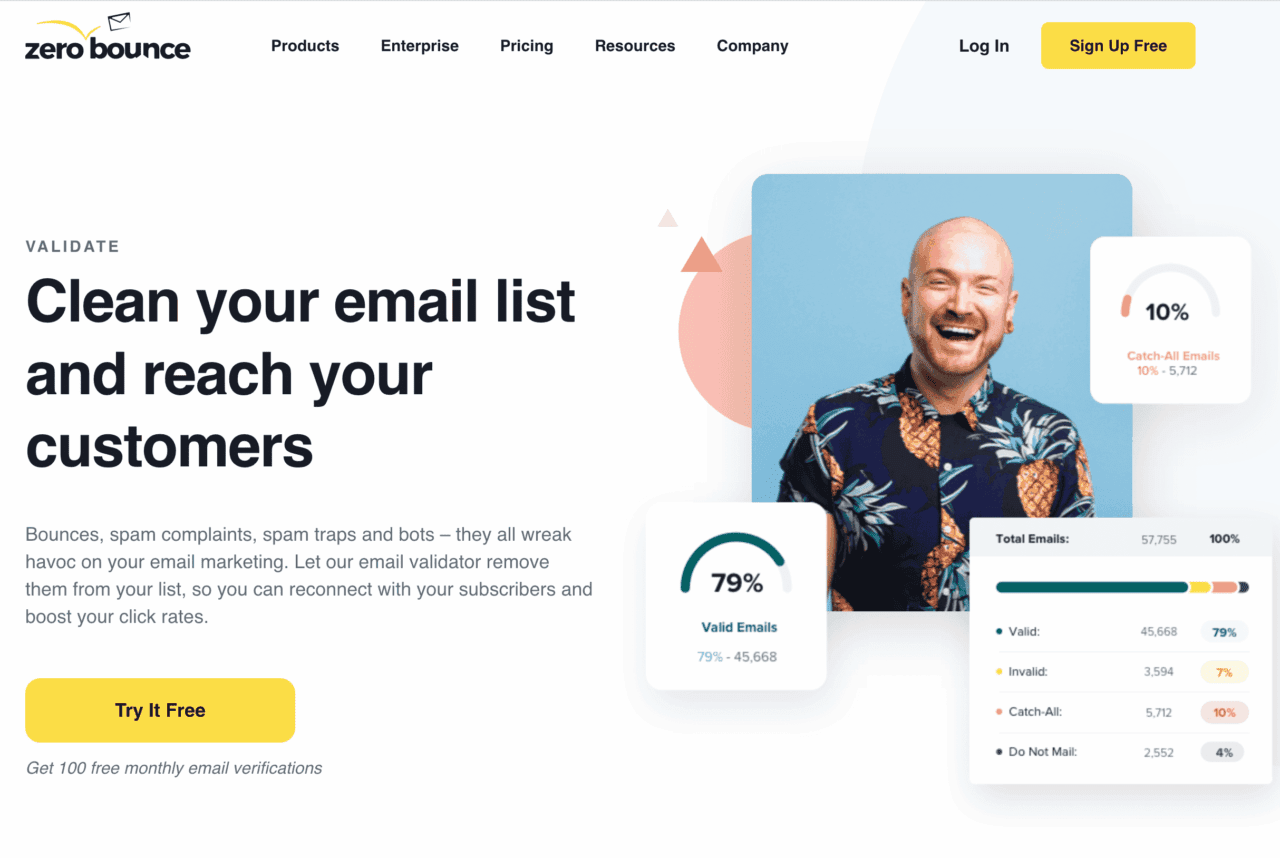
3 Reasons Why Businesses Should Verify Email Addresses
A clean, valid email list is an email marketer’s number one asset. See why you should verify email addresses and how it helps you engage your subscribers and increase sales.
Marketers and business managers are more aware than ever of the inherent value of email addresses. Gone are the days when email signup was relegated to a clipboard and a ballpoint pen.
Those who succeed realize that an email address has a dollar value. The value depends on the email and consumer habits of the person behind it, with an average value of $113.48 per contact.
If an email address is so valuable, isn’t it worth it to keep it on your list, regardless of whether it’s been verified?
The answer is undoubtedly: no.
As you will soon see, keeping unverified email addresses on your list can prevent your emails from arriving. A bad email that looks just like any other can cause your list to unravel – and you’d never know it.
But checking an email address is more than just determining whether it exists or not.
Read on to find out why you should validate email addresses, and how that helps you achieve better email results.
What does it mean to verify email addresses?
Email verification is the process of determining whether an email address exists and whether it belongs to a real person. Furthermore, an email verification service ensures that the email address isn’t harmful.
How could an email address be harmful?
Certain types of emails are not just worthless from a marketing perspective. They can actually hurt your email reputation and cause your email deliverability to sink.
Emailing these contacts sends a message to Internet service providers (ISPs) that you are a likely spammer. Spammers don’t care about the quality of their contacts – they’ll email any address they can find. When you build a similar reputation, your messages start going to the junk folder.
Email verification can involve:
- checking a single email address
- verifying a list with thousands or even millions of emails
- or validating emails in real time, before you add them to your database.
Once your email validator deems an email address problematic, you should remove it without delay. Otherwise, you’re gambling with your email deliverability and email marketing budget.

Why you should verify the email addresses on your list
Email lists deteriorate. On average, about 25% of your emails go bad every year. The pandemic has made things worse, with data decaying even faster.
Keeping outdated emails in your database or CRM is detrimental because:
- You’re paying to store useless data.
- Those email addresses will affect your overall email results.
Think about it: what good is an email you sent if it ends up in the junk folder? Verifying email addresses is one of the best ways to increase your chances of landing in the inbox.
For any business that uses email marketing, email verification is an investment of time and money. Without it, you might be sending emails to fake addresses and not communicating with real people.
Email validation also helps you prevent email blacklisting and ensure your work doesn’t go to waste.
ZeroBounce customer Bruce Herwig, a marketing director at Image Source, confirms: “Email verification works by confirming there is a valid email on the receiving end. Typos happen. People constantly move jobs, so your database is always out of date. By verifying your address, you are ensured maximum deliverability to the intended audience.”
Related: Let’s Talk About Email: Bruce Herwig of Image Source
Let’s take a closer look at the top reasons why you should verify your email list and how that helps you run more successful email campaigns.
#1. Safeguard your sender reputation
One of the reasons email marketers struggle to reach customers is a tarnished sender reputation.
Your sender reputation (or sender score) is the metric ISPs use to decide whether your emails are legitimate or spam. With a good sender reputation, your emails have a fighting chance. If your reputation suffers, the success you seek hangs by a thread.
All kinds of things can hurt your sender reputation. For example, if you send a slew of unexpected emails, many will hit the unsubscribe button. It’s one of the reasons why you should send material that your reader expects. Just as important is that you send at regular intervals.
Low-quality or invalid email addresses can only hurt your sender reputation. To preserve and protect it, verifying your email list consistently is a must. If you don’t, you’re only rolling the dice.
#2. Eliminate bad data
Some damaging emails won’t necessarily bounce, but will nonetheless chip away at your email deliverability rate.
Let’s look at a few of them.
Abuse emails
These contacts belong to individuals who make a habit of marking emails (even those they signed up for) as spam. They do it for a variety of reasons, from maliciousness to carelessness.
No matter the motive, they have a high likelihood of flagging you as spam. They’re not good candidates for your list, and a good email verifier will root them out.
Role-based emails
These are the email addresses like info@, admin@ or office@.
They tend to be checked by a whole team instead of just one person and are more trouble than they’re worth. You can’t know if someone who has access to such an email address will decide to mark you as spam. Or one of the people who checks that email will delete the email without opening it.
You have a low likelihood of marketing success with role-based emails. Of course, you could choose to keep them on your list, but the chance of negative consequences is high.

Spam traps
Internet Service Providers (ISPs) and anti-spam organizations create spam trap email addresses and place them on the Internet to lure and block spammers. When your email hits a spam trap, your sender reputation declines, and so does your email deliverability.
Some email verification tools can identify spam traps. Weeding them out is the best strategy.
Disposable emails
Some call them burner or temporary email addresses. Disposable emails are generated by websites that promise an email address with a short lifespan. They bounce and hurt your sender score or reputation.
People will use them when they don’t want to give you their real email address. One of the prevalent reasons is to get a freebie – an ebook, mp3 download, or other goody that you’re giving away. But that’s the limit of their interest. The person behind a disposable email has no real authentic connection to what you offer.
#3. Keep your email engagement high
Your email engagement is the rate at which people interact with your emails. This includes opening, clicking-through, or replying to your emails. Even unsubscribing is a form of engagement.
Your engagement and sender reputation are intertwined. Low engagement leads to a decrease in the sender reputation. Furthermore, a bad sender reputation leaves little chance of getting good engagement.
So how do you increase engagement?
The best way is to send exceptional emails. Make sure that the emails you send are of use to those who signed up to receive them. It also means that you only send emails to those who have requested them and have confirmed their interest with a double opt-in.
However, the best emails in the world will make no difference if your list contains unverified email addresses. Some of them may be because of typos, others could be abandoned, role-based or spam traps.
Verifying your email addresses ensures that only real prospects receive what you send. You also prevent your good engagement from dwindling. Always monitor your engagement. It means being conscientious about not only what you send, but who you send it to.
Now that you understand how critical email scrubbing is, let’s see how you can get started and what your options are. The good news is how simple it is!
How to verify email addresses in bulk
If you’ve never validated your email list, it’s wise to start with bulk email verification. That means taking your entire list and uploading it to an email validation platform.
ZeroBounce takes about 45 minutes to check 100,000 email contacts, so you can begin using your clean email list on the same day.
Now that you’ve verified your list, you’ll need to repeat your email list cleaning periodically. Quarterly is the minimum, with different types of lists requiring even more frequent checking.

How to verify email addresses in real time
If you just cleaned your list, it stands to reason that you’ll do whatever you can to maintain its health. Having lots of sign-up forms is a smart move because it makes it easier for anyone to enroll to receive your emails.
However, what is to prevent bad data from infecting your list again? That’s a great point that some will overlook.
The internet is full of bots, some of which will infest legitimate email lists. The answer, yet again, is to check your email contacts periodically but also, verify them before they’re added to your list.
Yes, you can verify email addresses in real time, with the help of an API. For instance, ZeroBounce offers an email verification API that you can connect to your sign-up forms.
Suppose someone signs up and makes a typo. The API will detect it and let the person know, in real time, that they made a mistake. The ZeroBounce API will even suggest your new subscriber to correct their typo.
Checking emails in real time stops half-hearted subscribers from the get-go. It also prevents any damaging emails from finding their way onto your list. Whether typos, abuse, role-based or spam trap emails, the API detects them and prevents them from getting on your list.
Check emails in both bulk and real time
Verifying your email list in bulk a few times a year is a good way to preserve your sender reputation and help your campaigns land in the inbox.
But if you really want to do things by the book, use both bulk and real-time email verification to stay on top of data decay. This dual approach will help any email program have the best chance at effectiveness.
It preserves your sender reputation and keeps your engagement up. It’s why you should verify email addresses to ensure that your efforts, and financial and time resources, don’t go to waste.
FAQs about verifying email addresses
Using an email verifier preserves the quality of your email list. It is the leading way to identify problematic and invalid email addresses that are sure to cause sender reputation to diminish and list quality to decline.
An email verifier is an online tool that verifies whether email addresses are working,
connected to a real person, and is not harmful. It identifies fake or inactive email
addresses so that you can remove them from your list and divert any data decay.
To verify that an email is valid, you must use email validation software. An email validator will verify email addresses in bulk or one-by-one. You can also verify emails at the signup by way of an email verification API. The API checks emails in real-time.
Table of Contents
- What does it mean to verify email addresses?
- Why you should verify the email addresses on your list
- #1. Safeguard your sender reputation
- #2. Eliminate bad data
- Abuse emails
- Role-based emails
- Spam traps
- Disposable emails
- #3. Keep your email engagement high
- How to verify email addresses in bulk
- How to verify email addresses in real time
- Check emails in both bulk and real time
- FAQs about verifying email addresses






